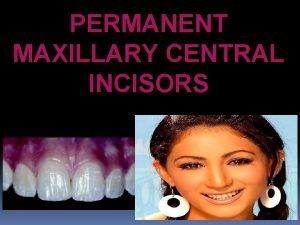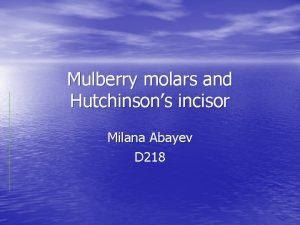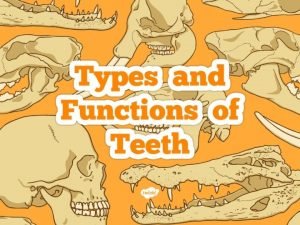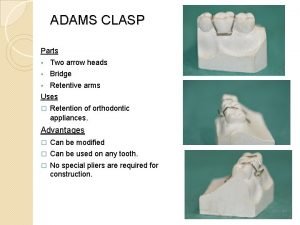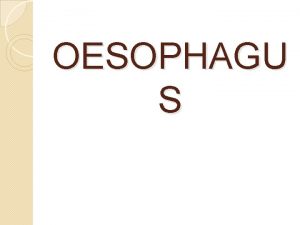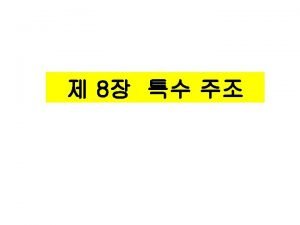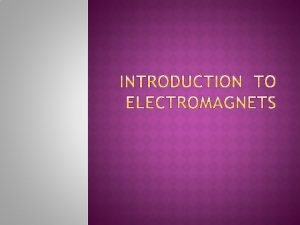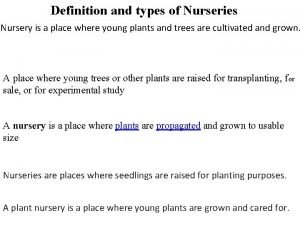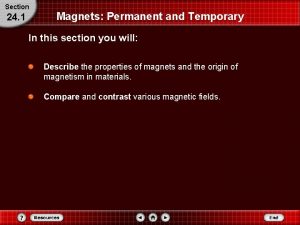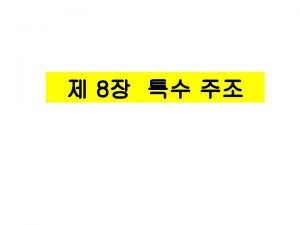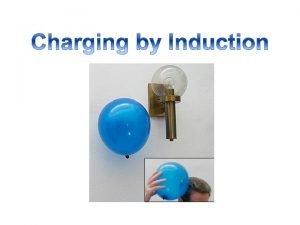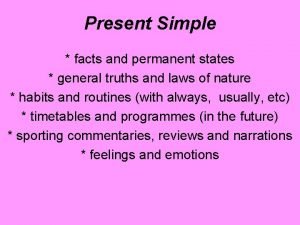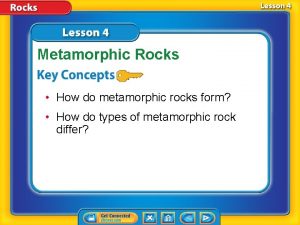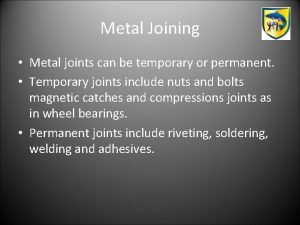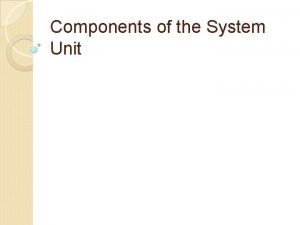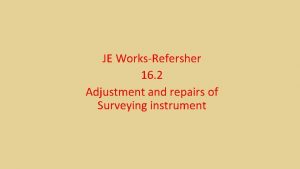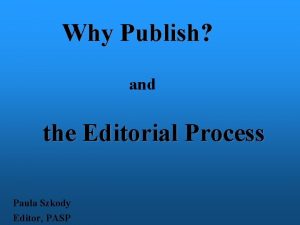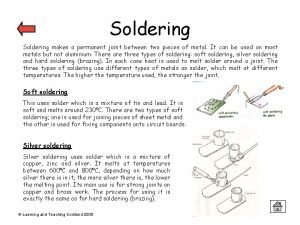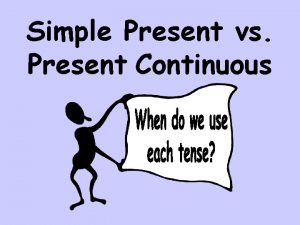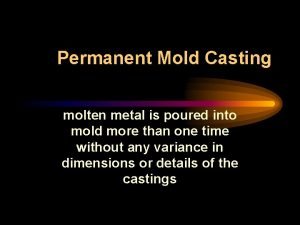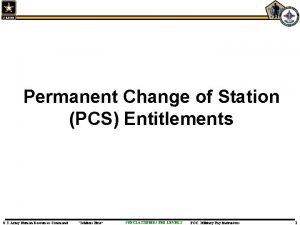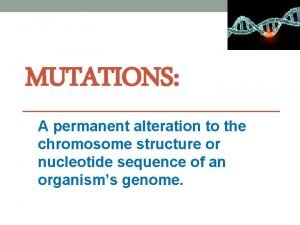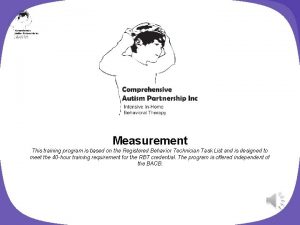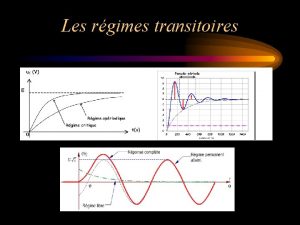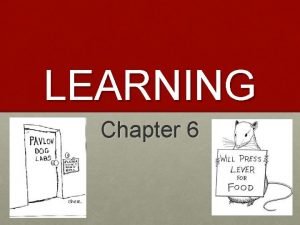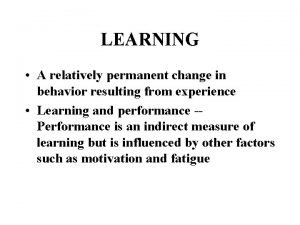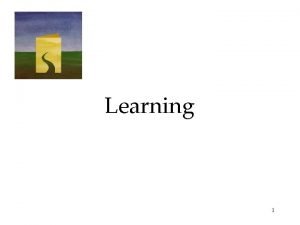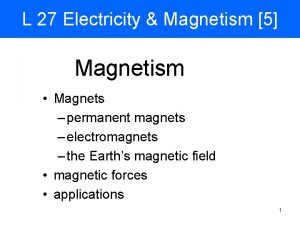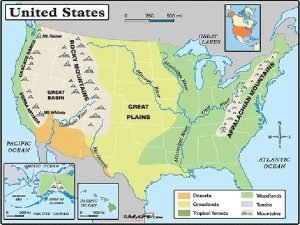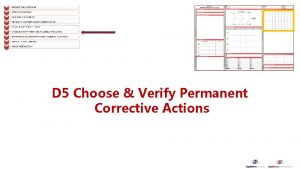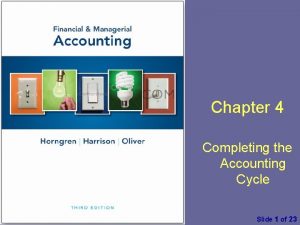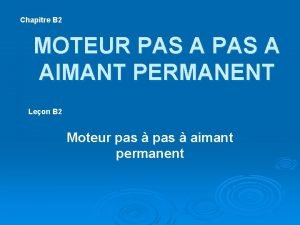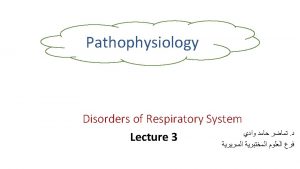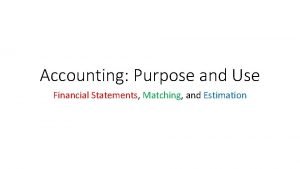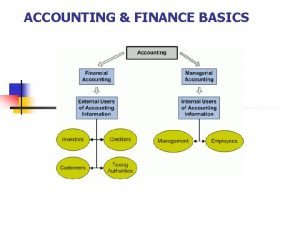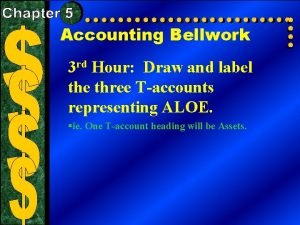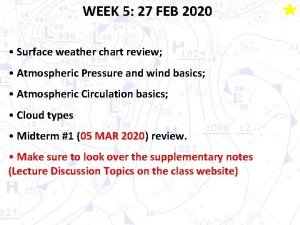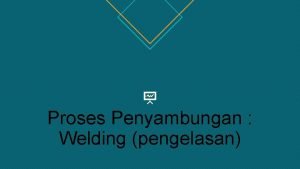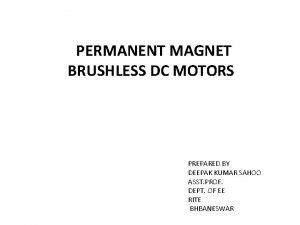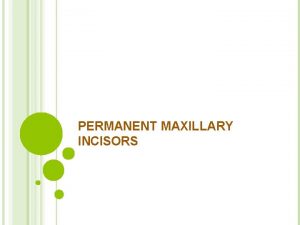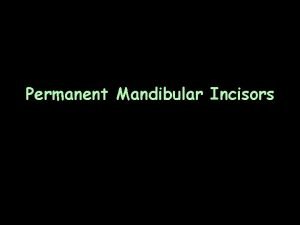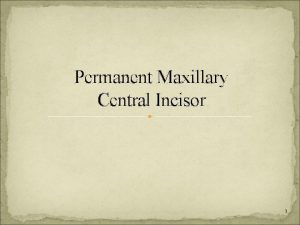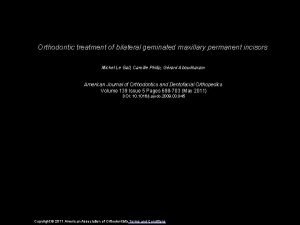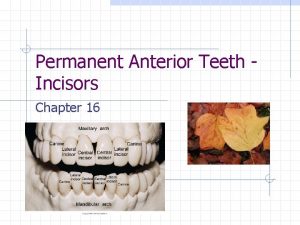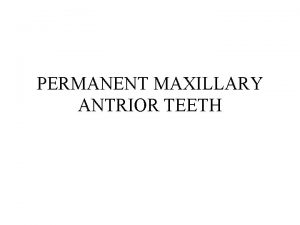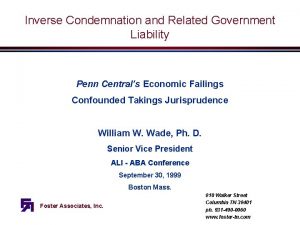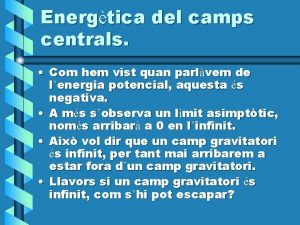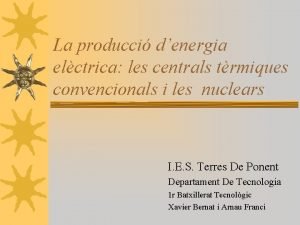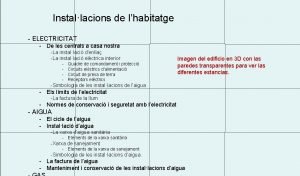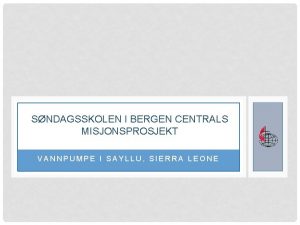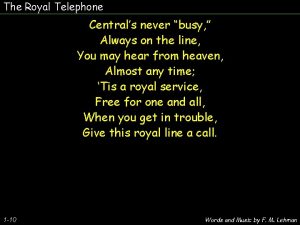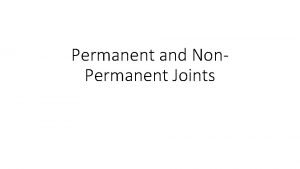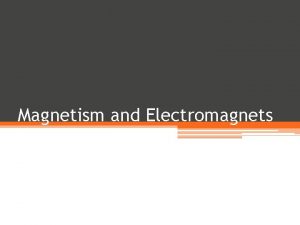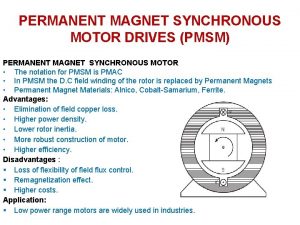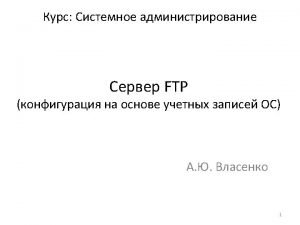Permanent Incisors Introduction Centrals and laterals 7 8


























































- Slides: 58

Permanent Incisors

Introduction: • • Centrals and laterals #7, 8, 9, 10 and 23, 24, 25, 26 Maxillary larger than mandibular Important in esthetics, mastication, phonetics


Terminology: CEJ mamelons cingulum lingual fossa marginal ridge

Some common traits: • Incisal edge present = incisor • Mamelons: 2 or 3 • Marginal ridges more parallel to long axis • Presence of lingual fossa and cingulum


Permanent Maxillary Central Incisor

General characteristics: • Arch position: on either side of midline – Adjacent mesial surfaces • Universal #8 and #9 • M-D almost as wide as I-C dimension* • Wider M-D than F-L* (I-C > M-D > F-L) • Widest M-D of all anterior teeth* *type trait



Development timeline* • • Beginning calcification: 3 - 4 months Completion of enamel: 4 - 5 years Eruption: 7 - 8 years Root completion: 10 years (2 years later) *Fuller/Denehy

Labial View • Basic crown shape is trapezoidal • Surface generally flat, developmental depressions visible • M-D and I-C dimension more nearly equal* (as compared to other incisors) • Cervical line more flat (more than any other anterior teeth)

Labial view: • Incisal edge perpendicular to long axis • Facial height of contour in cervical third • Mamelons visible in newly erupted teeth

Labial view: mesial outline • Mesial outline nearly straight • MI angle sharp • Mesial contact area (HOC) at incisal third

Labial view: distal outline • Outline more convex than mesial • DI angle more rounded • Distal contact area (HOC) near junction of incisal-middle third

Lingual View • Slightly narrower M-D than labial • Surface has both convexity and concavity – – Marginal ridges, M and D Cingulum Lingual fossa Incisal ridge

Lingual view: • M and D outlines similar to labial view • CE curvature greater than labial, slight offset to distal • Lingual height of contour at cervical third • M and D marginal ridges border lingual fossa

Mesial View • Crown basically triangular • Mesial CE line curvature is greatest of any tooth* • Incisal edge is in line with long axis • Mesial height of contour (mesial contact area) at incisal third

Mesial view: • Labial outline – slightly convex – height of contour at cervical third – incisal 2/3 nearly flat • Lingual outline: S-shape – concave incisally – convex cervically – height of contour at cervical third • Incisal edge slopes lingually

Distal View • Generally similar to mesial • Distal surface slightly more convex than mesial • CE line curvature is less than mesial • Distal HOC near junction of -middle third incisal

Incisal View • • Roughly triangular outline* Lingual narrower than labial Wider M-D than F-L* Incisal edge is midway faciolingually *type trait

Root • Single, conical, straight • Cross-section at cervical roughly triangular* • Ratio of crown to root: 2/5 to 3/5

How to tell if you have a maxillary central: • Presence of incisal edge, sloping lingually • M-D width broad (8 -9 mm) – M-D almost as wide as I-C dimension* • Wider M-D than F-L* – I-C > M-D > F-L • Relatively flat labial surface • M and D incisal corners relatively sharp • Root cross-section more triangular

How to distinguish right from left: • Mesial outline straighter than distal* (distal has more convexity than mesial) • MI angle is sharper than DI* • CE line curvature is greater on mesial* • Mesial HOC more incisal than distal* • Lingual cervical line sometimes offset distally






Next… Maxillary Lateral Incisor

Permanent Maxillary Lateral Incisor

General Characteristics • Second tooth from midline • Between maxillary central and maxillary canine • Universal numbers: #7 and #10 • Resembles maxillary central except: – Smaller in all dimensions except root length* – Generally more rounded – Displays more variation in form




Development Timeline: • • Beginning calcification: 1 year Completion of enamel: 4 - 5 years Eruption: 8 - 9 years Root completion: 11 years

Labial View • Mesial outline – More convexity than mesial of central – HOC (contact area) is at incisal third (closer to the junction of the incisal and middle thirds)

Labial View • Distal outline – DI corner noticeably more rounded than MI (most rounded incisal corner*) – HOC is at junction of incisal-middle third to the middle of the middle third

Labial view: • Incisal outline – More rounded than central esp. DI corner – Greatest rounding of any incisor* • Labial height of contour: cervical third

Lingual View • • Marginal ridges more prominent Lingual fossa deeper Lingual pit often present Linguogingival fissure sometimes present • Height of contour at cervical third

Mesial View • Labial outline is convex • Lingual outline is S-shape • CE line curvature greater than distal • Incisal edge is inline with long axis of tooth • Mesial HOC near junction of incisal and middle 1/3

Distal View • Similar to mesial except – HOC more cervical (closer †o middle 1/3) – CE line curvature less than mesial

Incisal View • Generally more convexity than central • MD ≥ FL dimension • Incisal edge is midway faciolingually

Root • Single rooted • Root wider F-L than M-D • Apical third may be deflected distally* • Cross-section more ovoid than central

Variations and anomalies: • Most variations in form besides third molars* • May be congenitally missing • “Peg” lateral: peg-shaped crown

How to tell if you have a maxillary lateral: • • • Smaller in size than max central More distinct lingual anatomy Presence of deeper lingual fossa Presence of lingual pit Incisal outline more rounded M and D outlines more rounded


How to tell right from left: • MI corner sharper than DI corner* • Mesial CE line curvature greater than distal • Mesial height of contour more incisal than distal’s* • Distal outline more convex* • Apex deflected distally




Laboratory Project

For lab today…

Boley Gauge



Video of lab project…

? ? ? Questions ? ? ? ? ?
 Incisal ridge of central incisor
Incisal ridge of central incisor Hutchinson incisors and mulberry molars
Hutchinson incisors and mulberry molars Functions of the incisors
Functions of the incisors Adams clasp activation
Adams clasp activation 25 cm from incisors
25 cm from incisors Gingival third vs cervical third
Gingival third vs cervical third Advantages and disadvantages of hot chamber die casting
Advantages and disadvantages of hot chamber die casting Temporary vs permanent magnets
Temporary vs permanent magnets Type of nursery
Type of nursery Difference between permanent magnet and temporary magnet
Difference between permanent magnet and temporary magnet Disadvantages of permanent mold casting
Disadvantages of permanent mold casting Semi permanent joints
Semi permanent joints Pull factors of migration
Pull factors of migration Examples of electromagnets
Examples of electromagnets Is charging by induction temporary or permanent
Is charging by induction temporary or permanent Permanent states
Permanent states Permanent bending and folding of rocks without melting
Permanent bending and folding of rocks without melting Temporary joining methods for metal
Temporary joining methods for metal The relatively permanent and limitless storehouse
The relatively permanent and limitless storehouse What is the electronic component that interprets
What is the electronic component that interprets Temporary and permanent adjustment of theodolite
Temporary and permanent adjustment of theodolite Augustus built a permanent and professional ________.
Augustus built a permanent and professional ________. Essay structure introduction
Essay structure introduction Electronic tattoos ted talk
Electronic tattoos ted talk Traditional wood joints
Traditional wood joints Paula szkody
Paula szkody Face of weld
Face of weld Discuss how permanent hardness of water can be removed
Discuss how permanent hardness of water can be removed Is soldering a permanent joint
Is soldering a permanent joint Remember simple present
Remember simple present Permanent sterility
Permanent sterility Graphite permanent mold casting
Graphite permanent mold casting Dd form 2560 advance pay certification/authorization
Dd form 2560 advance pay certification/authorization A permanent alteration that changes a dna sequence
A permanent alteration that changes a dna sequence Permanent move to a new location is
Permanent move to a new location is Permanent product recording data sheet
Permanent product recording data sheet Régime permanent et transitoire
Régime permanent et transitoire Joint de oldham
Joint de oldham Relatively permanent means
Relatively permanent means Is the systematic relatively permanent
Is the systematic relatively permanent Relatively permanent
Relatively permanent Relatively permanent change meaning
Relatively permanent change meaning What are magnets made of
What are magnets made of 1st permanent english settlement
1st permanent english settlement Fprn dynamic map
Fprn dynamic map Dossier permanent audit exemple
Dossier permanent audit exemple Permanent corrective action
Permanent corrective action Permanent accounts
Permanent accounts Ch 20 chemical texture services
Ch 20 chemical texture services Moteur pas à pas à aimant permanent
Moteur pas à pas à aimant permanent The permanent dilation of the bronchi
The permanent dilation of the bronchi Permanent accounts
Permanent accounts Permanent accounts
Permanent accounts Permanent accounts
Permanent accounts Surface pressure map
Surface pressure map The nature of drama
The nature of drama Permanent wilting point
Permanent wilting point Proses joining manufaktur
Proses joining manufaktur Blpm classified as
Blpm classified as
